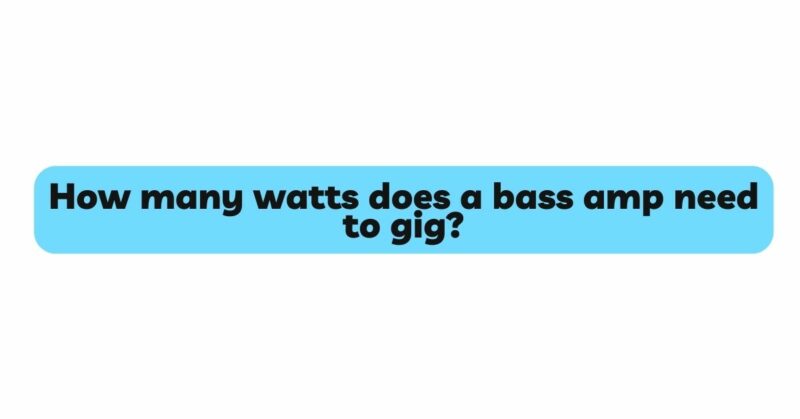As a bassist, the heartbeat of the rhythm section, your role is to provide the foundation that drives the music forward. When it comes to live performances, the power of your bass amp is pivotal in ensuring your low-frequency prowess reaches the audience with impact and clarity. The question that often reverberates among bassists is: How many watts does a bass amp need to conquer the gig? The answer to this question involves a symphony of factors, including venue size, musical style, amp efficiency, and sonic expectations. This article embarks on a deep dive into the world of bass amplification, dissecting the intricacies of wattage for live gigs and uncovering the harmony between power, presence, and the groove.
The Wattage Equation: Understanding Amplifier Power: Wattage is a measurement of power, representing how much energy an amplifier can deliver to your speakers. However, the correlation between wattage and perceived volume isn’t linear. Doubling the wattage doesn’t double the perceived loudness. Instead, each 3 dB increase in wattage results in a noticeable but not overwhelming increase in volume.
Venue Size and Acoustic Impact: The size of the gigging venue is a crucial consideration. In smaller spaces like cafes or intimate clubs, a lower wattage can often suffice, as the sound doesn’t need to travel far to reach the audience. In larger venues or outdoor settings, however, you’ll need more wattage to ensure your bass lines penetrate the space effectively.
The Low-End Challenge: Bass frequencies, being lower in pitch, require more power to cut through the mix and create impact. This means that bass amps need more wattage to deliver a perceived volume similar to that of amps used for midrange or treble instruments. Therefore, it’s essential to keep in mind that the demands of the bass register can influence your wattage requirements.
Amplifier Design and Efficiency: Different amplifier classes, such as Class A, Class AB, and Class D, offer varying efficiency and tonal characteristics. Class D amplifiers are known for their high efficiency and are commonly used in bass amps. They can deliver more sound output per watt, making them an attractive choice for gigging scenarios.
Playing Style and Musical Genre: The style of music you play is a significant determinant of your amplifier needs. If you’re a bassist who lays down intricate basslines, slaps, and employs fingerstyle playing, your amp will need enough wattage to capture every nuance. On the other hand, genres that emphasize deep bass, such as reggae or funk, might demand more wattage to deliver the required thump.
Band Dynamics and Instrument Balance: Consider the overall mix of your band. If you’re part of a larger ensemble with drums, guitars, vocals, and possibly keyboards, your bass needs to coexist harmoniously without overshadowing the other instruments. The right wattage ensures your bass is prominent but balanced.
Headroom and Clarity: Headroom refers to the ability of an amplifier to handle sudden volume spikes without distorting. It’s crucial for maintaining sonic integrity, especially when your playing involves dynamics. A higher wattage bass amp offers greater headroom, allowing your sound to remain clean even during intense playing moments.
Sound Reinforcement and Mic’ing: In many live scenarios, bass amps are mic’d and integrated into the venue’s sound reinforcement system. This means that the amp’s output is combined with the venue’s speakers to ensure uniform sound distribution. As a result, the wattage of your amp doesn’t solely dictate the perceived volume, as the sound reinforcement system contributes significantly.
Balancing Power and Portability: While higher wattages can deliver more volume and headroom, consider the practicality of transporting and setting up your gear. Gigging often involves moving equipment, and a balance between power and portability is essential. A higher wattage amp might offer more potential, but a well-designed lower wattage amp can also deliver impressive results.
Tonal Character and Speaker Sensitivity: Beyond raw power, consider the tonal characteristics of your amp and the sensitivity of your speakers. Some bass amps are designed to provide a particular tonal flavor, whether it’s warm and vintage or modern and punchy. Additionally, pairing your amp with sensitive speakers can enhance its perceived loudness.
Sound Checks and Venue Acoustics: Before any gig, conducting thorough sound checks in the actual venue is essential. It allows you to tailor your bass amp’s settings to the acoustics of the space, ensuring your sound translates optimally to the audience.
Conclusion: The ideal wattage for a gigging bass amp is an equation that intertwines venue size, musical style, amplifier efficiency, and your personal playing preferences. While there’s no one-size-fits-all answer, understanding the factors at play empowers you to make an informed decision. Whether you’re wielding a lower wattage amp with finesse or harnessing the power of a higher wattage beast, the goal is to create a sonic foundation that locks into the groove, resonates with both you and your fellow musicians, and leaves the audience swaying to your bass-driven rhythm.


